
Sumatra is one of the Sunda Islands of western Indonesia. It is the largest island that is fully within Indonesian territory, as well as the sixth-largest island in the world at 475,807.63 km2 (182,812 mi.2), including adjacent islands such as the Simeulue, Nias, Mentawai, Enggano, Riau Islands, Bangka Belitung and Krakatoa archipelago.

West Sumatra is a province of Indonesia. It is on the west coast of the island of Sumatra and includes the Mentawai Islands off that coast. West Sumatra borders the Indian Ocean to the west, as well as the provinces of North Sumatra to the north, Riau to the northeast, Jambi to the southeast, and Bengkulu to the south. The province has an area of 42,119.54 km2 (16,262.45 sq mi), with a population of 5,534,472 at the 2020 census. The official estimate at mid 2022 was 5,640,629. The province is subdivided into twelve regencies and seven cities. It has relatively more cities than other provinces outside Java, although several of them are relatively low in population compared with cities elsewhere in Indonesia. Padang is the province's capital and largest city.
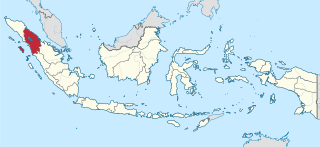
North Sumatra is a province of Indonesia located on the northern part of the island of Sumatra. Its capital and largest city is Medan. It is bordered by Aceh on the northwest and Riau and West Sumatra in the southeast, with two different coastlines located on the Indian Ocean and the Strait of Malacca, and a maritime border with Malaysia to the east. North Sumatra is Indonesia's fourth most populous province after West Java, East Java and Central Java, and the third-largest province on the island of Sumatra after the neighbouring Riau. It covers an area of 72,981 km2. According to the 2020 census, the province's population in that year was 14,799,361. The mid-2022 official estimate was 15,115,206. North Sumatra is a multi-ethnic province. The Malay people are regarded as the natives of the east coast of the province, while the west coast of the province is mainly inhabited by the Batak. The central highlands region around Lake Toba is predominantly inhabited by other Batak groups. The Nias people are natives to Nias Island and its surrounding islets. With the opening of tobacco plantations in East Sumatra during the colonial era, the colonial government employed many contract labourers for plantations, mainly Chinese, Javanese and Indian migrants. The majority did not return after their contract ended and decided to stay in the province. The recent rapid urbanisation also attracted neighbouring people from Aceh, Riau and West Sumatra.

West Kalimantan is a province of Indonesia. It is one of five Indonesian provinces comprising Kalimantan, the Indonesian part of the island of Borneo. Its capital and largest city is Pontianak. It is bordered by East Kalimantan and Central Kalimantan to the east, the Malaysian state of Sarawak to the north, and the Indian Ocean to the west and the Java Sea to the south. The province has an area of 147,307 km2, and had a population of 4,395,983 at the 2010 Census and 5,414,390 at the 2020 Census; the official estimate as at mid 2022 was 5,541,376. Ethnic groups include the Dayak, Malay, Chinese, Javanese, Bugis, and Madurese. The borders of West Kalimantan roughly trace the mountain ranges surrounding the vast watershed of the Kapuas River, which drains most of the province. The province shares land borders with Central Kalimantan to the southeast, East Kalimantan to the east, and the Malaysian territory of Sarawak to the north.

The kampilan is a type of single-edged sword, traditionally used by various ethnic groups in the Philippine archipelago. It has a distinct profile, with the tapered blade being much broader and thinner at the point than at its base, sometimes with a protruding spikelet along the flat side of the tip. The design of the pommel varies between ethnic groups, but it usually depicts either a buaya (crocodile), a bakunawa, a kalaw (hornbill), or a kakatua (cockatoo)..

The culture of Indonesia has been shaped by long interaction between original indigenous customs and multiple foreign influences. Indonesia is centrally-located along ancient trading routes between the Far East, South Asia and the Middle East, resulting in many cultural practices being strongly influenced by a multitude of religions, including Buddhism, Christianity, Confucianism, Hinduism, and Islam, all strong in the major trading cities. The result is a complex cultural mixture, often different from the original indigenous cultures.

Nias is an island located off the western coast of Sumatra, Indonesia. Nias is also the name of the archipelago of which the island is the centre, but also includes the Batu Islands to the south-east and the small Hinako Islands to the west. Nias Island covers an area of 5,625.0 km2 (2,171.8 sq mi). It is mostly a lowland area rising to around 800 m (2,600 ft) above sea level. There were 756,338 inhabitants on the island at the 2010 Census; at the 2015 Intermediate Census this had risen to 798,506 and the 2020 Census resulted in a total of 880,550. The official estimate as at mid 2022 was 902,632.

Dance in Indonesia reflects the country's diversity of ethnicities and cultures. There are more than 1,300 ethnic groups in Indonesia. Austronesian roots and Melanesian tribal forms are visible, and influences ranging from neighboring Asian and even western styles through colonization. Each ethnic group has its own dances: there are more than 3,000 original dance forms in Indonesia. The old traditions of dance and drama are being preserved in the many dance schools which flourish not only in the courts but also in the modern, government-run or supervised art academies.

Indang also called Dindin badindin is a traditional Minangkabau Islamic dance originating from West Sumatra, Indonesia. Indang dance grows and develops in the Minangkabau community as a portrayal of the arrival of Islam in West Sumatra in the 13th century.
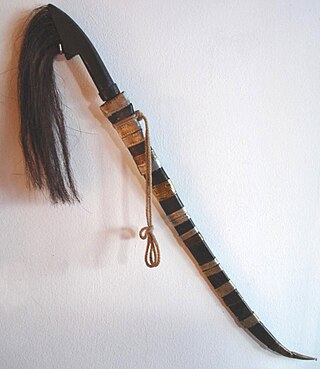
The surik is a traditional sword native to the island of Timor or Nusa Tenggara in wider extent, as well as Sumatra. The first coat of arms of East Timor depicted crossed suriks.

Balato is a sword that originates from Nias, an island off the west coast of North Sumatra, Indonesia.
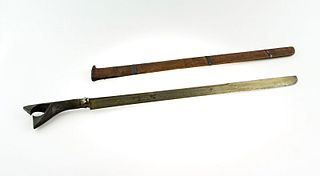
Sikin Panjang is a sword originated from northern Sumatra, Indonesia.

Gari is a sword that originates from Nias, an island off the west coast of North Sumatra, Indonesia. It is a term used for a type of sword found only in North Nias.

Peurawot is a traditional whittling knife of the Acehnese people from Aceh, Indonesia.

Si Euli is a traditional dagger or knife that originates from Nias, an island off the west coast of North Sumatra, Indonesia. There are versions of this knife worn by men or for daily use.

Nias people are an ethnic group native to Nias, an island off the west coast of North Sumatra, Indonesia. In the Nias language, the Nias people are known as Ono Niha, which literally means 'descendants of human'. Nias island is known as Tanö Niha, with Tanö meaning 'land' in the Nias language.

Peurise Teumaga or Peurise Lembaga is a shield originating from Aceh, Indonesia. This shield is very identical to the Peurise Awe, except that it is made of brass instead of rattan. The shield was also used by Acehnese warriors during the Aceh War against the Dutch colonials in the 19th century.
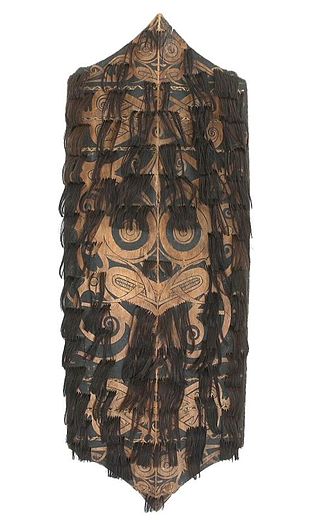
The Klebit Bok or Kelavit Bok is the traditional shield of the Kayan and the Kenyah people originating from Borneo. It is similar to the shields used by other Dayak people such as the Kliau of the Iban.
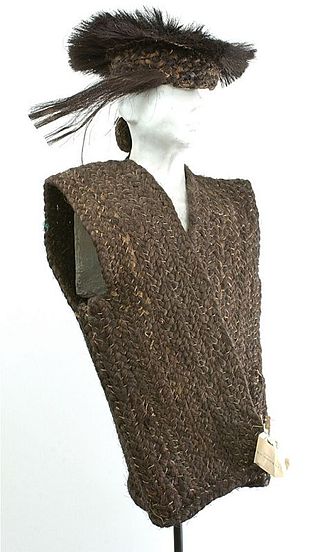
The BaruLema'a is a traditional armor from Indonesia.
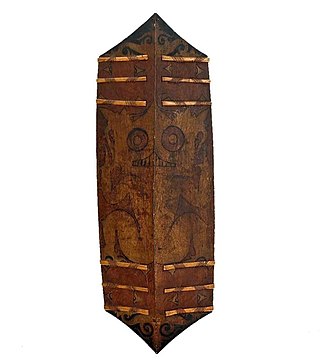
The Kliau, Keliau or Klau is a traditional shield of the Dayak people of Borneo. It is similar to the shields used by other Dayak people such as the Klebit Bok of the Kenyah. Other names for this shield include: klawang or kelawang and trabai or terabai.























